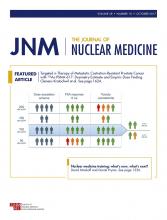This month’s “Hot Topics” contribution features an interesting commentary by Drs. Mankoff and Pryma, who discuss the rapidly changing training requirements for diagnostic and therapeutic molecular imaging and nuclear medicine. Their assessment concludes with a proposed 16-mo training pathway (in either nuclear medicine or nuclear radiology) embedded into a 4-y diagnostic radiology residency (1).
This idea is based on the notion that nuclear medicine has to be part of radiology—a reality that exists in the United States but not in many other regions of the world, where nuclear medicine is a strong, independent discipline.
I am confident and hope that The Journal of Nuclear Medicine will receive a large number of comments that will lead to a useful discussion about training requirements. There are several key questions that we need to answer. First, is nuclear medicine necessarily a division of radiology? (I personally think that it is not. Cross-sectional imaging is of course an important component of nuclear medicine training.) Second, what will the nuclear medicine practice look like in 5–10 y? Third, how will we address and meet the needs of theranostic programs? And fourth, how will theranostics fit into the workflow of nuclear medicine?
My personal view differs from that of Mankoff and Pryma. I see the field moving into therapy (precision medicine), which has entirely different training demands. Nuclear medicine originated in medicine and not in radiology. In large parts of the world, nuclear medicine is independent and thriving. Recent major advances such as the emerging field of theranostics originated largely in Europe. Why is this worth mentioning? Because many European countries created successful dedicated 5-y nuclear medicine training programs. Graduates of these programs are highly skilled experts that have shaped the field for more than a decade.
Johannes Czernin
Of course, hybrid imaging is important, and image interpretation requires extensive cross-sectional imaging training. Yet equally important are newly developing relationships with urology (prostate-specific membrane antigen–targeted theranostics, bone metastasis treatments), radiation oncology (theranostics), endocrinology, oncology (somatostatin receptor–targeted theranostics, bone pain treatments), and others. Added to these relationships are our close interactions with cardiology, neurology, and medicine (infection/inflammation). Moreover, the initially academic and subsequently translational and clinical applications of purposeful imaging probe development, tracer kinetics, molecular imaging in drug development, and others demand a curriculum that most certainly requires more than 16 mo of training. (Obviously, 16 mo is progress when compared with the 4 mo that thus far has sufficed to authorize radiologists to perform radionuclide therapies.)
We will of course invite leaders of the American Board of Nuclear Medicine to provide their views and vision of the future of the nuclear medicine training curriculum. We also ask for the opinions of leaders across the world and, finally yet importantly, invite our readers to comment on this discussion.
- © 2017 by the Society of Nuclear Medicine and Molecular Imaging.
REFERENCE
- 1.↵








